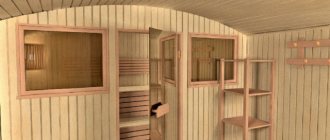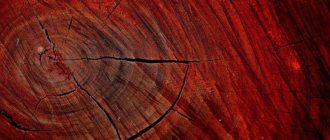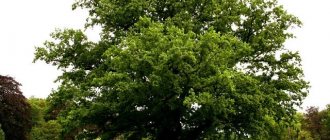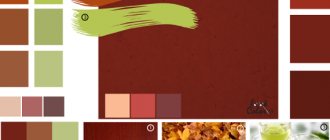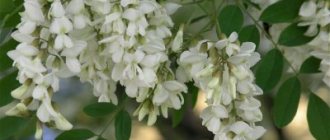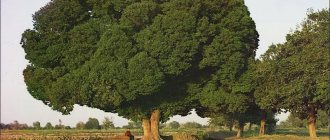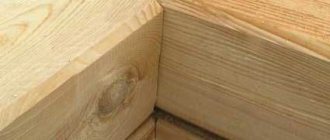Larch has been used by humans as a building and finishing material for a long time. The main reason for this choice is its exceptional strength. In addition, it is quite elastic, moisture-resistant, environmentally friendly, fireproof, can withstand very low temperatures and is resistant to rotting and fungal formations. An example of the reliability of products made from this wood are the piles on which Venice has been located for a very long time.
A curious representative of evergreen flora
Favorable conditions in which this plant of the pine family develops can contribute to its growth to forty meters or more. Its lifespan varies from three hundred to six hundred years, but there are known cases of these trees being eight hundred years old.
The initially existing cone-shaped crown becomes wide and spreading in old age. The small green or reddish-pink cones that ripen in spring can be round or ovoid in shape. When looking at a photo of larch, you can see its striking similarity to pine.
But the main property that distinguishes it from all other conifers is the shedding of needles for the winter. With the onset of spring, light green needles from one and a half to four centimeters long appear on the branches, which turn yellow by autumn. The color of the bark depends on the type of tree, which can be dark or light.
Where does it grow
In the European part of Russia, as well as in the Urals, it is almost impossible to find larch.
It is very rare to see its lonely plantings. Distributed throughout the Northern Hemisphere, in the Khabar Territory, in the Amur and Magadan regions. Larch is the mistress of the forest in Siberia. Increasingly, the plant is now being planted in the Moscow region.
Adapted to various living conditions, Larix can survive in severe frosts. In the countries of the former Soviet Union, forests occupy half a billion hectares of land. Of these, about half are larch. She considers severe frosts and angry snowstorms to be her native element. It rarely rains in this area, but this does not prevent the modryna from developing well.
This is interesting: without fear of other competitors, the tree grows in swamps and deserts, on mountain slopes and in rocky areas. Other tree species mainly choose one environment for their existence.
After the Ice Age ended on our planet, larch was one of the first to move towards the north. It first appeared in Chukotka and Taimyr. Some river valleys helped spread to the tundra. Even the harsh weather on the shores of the Arctic Ocean did not scare away this beauty.
There is a certain area in Siberia that the locals call “forest island”. No one will find any forest north of this in our world. So, there is only one tree species growing on this island, which is not surprising - this is the main character of our article.
You might also be interested in this article about Tamarix:
Scope of application
The wood material of this coniferous representative can be used in many cases. Furniture, parquet, and decorative interior elements are made from raw materials of the first grade, while roofs and supporting structures are made from lower grades.
Proper finishing of wood will prepare it for flooring, roofs, fences, facade decorations, external cladding of buildings, and foundations for interior partitions. The resistance of dry boards to moisture and high temperatures and the preservation of all properties allows for interior finishing of baths.
The sun and precipitation do not destroy the ground coverings of this plant outside buildings, so its use on balconies, terraces, paths and gazebos is the best choice.
How to grow larch in the garden
When planting and caring for larches, do not forget that these are “freedom-loving” plants. Only in an open place do they acquire the characteristic spreading shape of the crown. In shaded places and in dense plantings they are of little decorative value.
Larches are undemanding when it comes to soil; both sand and clay can be used for maintenance when growing trees, but these crops still give preference to light, fertile, slightly acidic loams.
Adult specimens have a powerful, branched root system and do not need feeding. Young plants can be fertilized in the spring after the snow melts on wet soil with complex or combined mineral fertilizer, but in no case with fresh manure and feces.
When caring for larches, replanting should be carried out either in early spring before buds open, or in autumn after the leaves turn yellow. In this case, it is possible to deepen the root collar, although it is not advisable. Plants with actively growing shoots require pruning, take root poorly and take a long time to get sick, so replanting them is not recommended.
Young larches easily tolerate replanting; large ones can be replanted only after preliminary preparation, when a dense lump is formed as a result of repeated pruning of the roots. If the plant is planned to be replanted in the fall, then pruning is carried out in the spring; for replanting in the spring, the plant is prepared in the summer of the previous year. In the process of caring for transplanted larches, you need to follow the same rules as when growing other conifers - water abundantly, and when replanting in spring, you also need to spray until the tree takes root.
Mature larches are extremely drought-resistant. Young plants require sufficient watering during the period of active growth and are able to tolerate the proximity of groundwater, but for adult plants, waterlogging is detrimental.
Most species are highly frost-resistant. Young summer shoots often suffer from late frosts, but grow back easily.
The next section of the article is devoted to how to propagate larch on a personal plot.
To avoid deception
In order not to be deceived when purchasing wood, you need to know what larch looks like. You can distinguish it from the pine offered by unscrupulous sellers by knowing a few simple rules:
- its knots, unlike pine ones (elongated oval, located at an angle to each other), are exclusively round;
- cut rings are brighter and thinner.
Also, in order for the quality of the product to be preserved for a long time, the raw materials should not even show signs of mold, the presence of a bug, or rot.
In order to get a good larch board when purchasing, it is advisable to contact proven and proven companies in the market, where an experienced specialist will help with its selection.
The main things you should pay attention to yourself are:
- standard dimensions: thickness – 20 mm, for floor – 30 mm; width – 60-120 mm;
- minimum of knots - no more than one per 17 cm;
- no cracks or holes;
- indication of the variety on the board or packaging.
In addition, the product must not be warped, damp, or have minimal or no resin pockets. No cracks or gaps are allowed between several boards located in contact. The size of side cracks on the edge should not exceed 40 mm.
The choice of board length is determined by the direction of its use and varies from five hundred to three thousand millimeters. But the best range is from one to two meters.
The color of dry larch can be distinguished from its family relative: depending on the type of tree, it varies from red-yellow with a slightly olive tint to reddish-brown.
The following will help you avoid running into defects, a substituted variety, or fraud when calculating the price:
- familiarization of the buyer with the Sorting Standards, which he has the right to demand from the seller;
- personal inspection of the goods;
- visit to production;
- independent calculation of the area of the material.
Growth and reproduction
The tree grows quickly, which is why it is valued.
Another advantage is its unpretentiousness in soil and weather. Therefore, larch is increasingly being planted in the country, in the home garden or in the form of coniferous alleys. Some gardeners try to grow the plant from seeds, but seedlings of certain varieties are quite difficult to find on sale. In order to plant seeds correctly, you need to choose cones that are not yet completely dry.
Most often, such cones are brown or brown in color. They need to be dried until the scales open. There are seeds inside, they are taken out and a month before planting they are placed in a special container with water for 24 hours.
Then it is mixed with sand and scattered into wooden containers with holes for ventilation. It is advisable to store it in a room with cool air, but the refrigerator is the best option.
They need to be planted in the ground at the end of April or at the beginning of May. The optimal depth for planting is 1 cm. When the sprouts reach 20 cm in height, they can be planted for better germination. For permanent habitat, larch is planted in spring and autumn.
The plant is grafted in a greenhouse in spring and summer. Rooting will occur within 90 days, after cuttings, provided that everything happens in a cool greenhouse.
If you are interested in the garden bean shrub, we recommend reading our article:
Categorization
The main criterion for determining the types of larch boards is the number and quality of existing knots. For example, “Extra” is a first-class material with an absolutely smooth surface that is free of any defects. “Prima” implies the presence of one knot on one product. In grades A, B, BC and C, their number varies from one or two per meter of length to an unlimited number.
Chemical composition
The unique properties of larch are due to its special chemical composition, which should be discussed in more detail.
Carotene
A first-class stimulant and antioxidant that protects the body from the negative effects of free radicals, which in turn significantly reduces the likelihood of developing cancer.
Lignin
Absorbs and then removes staphylococci, salmonella, toxins, ammonia, heavy metal salts, and a wide variety of allergens from the body, thus improving overall well-being.
Glycosides
They have a vasodilator and diuretic effect, promote easy discharge of sputum when coughing and neutralize pathogenic microbes.
Organic acids
Normalize digestion and restore the desired level of acidity. Stimulate the formation of red blood cells and improve blood clotting, as well as relieve inflammation and pain syndromes. In addition, organic acids contained in larch help normalize sleep.
Anthocyanins
These substances strengthen the heart muscle, blood vessels and capillaries, slow down the aging process and help prevent the development of Alzheimer's disease. Anthocyanins perfectly fight bacterial infections, relieve inflammation, normalize metabolic processes, stabilize the functions of the nervous system and significantly reduce the risk of diabetes and cancer.
Flavonoids
They are characterized by the ability to stabilize the functioning of the nervous system, and also normalize blood pressure and heart rate. Another beneficial property of flavonoids is to strengthen capillaries and improve blood clotting.
Gum
Reduces cholesterol and quickly removes toxins. It is used as a means to reduce appetite and to neutralize the negative effects of various medications, in particular antibiotics.
Some imperfections of a good tree
The large amount of resins contained makes the processing of larch timber very expensive. Very high density and humidity prevent good drying and cause difficulties during transportation. This affects the cost of wood and makes it one of the most expensive.
In addition, becoming even stronger over time, it can cause some difficulties with additional finishing during repair work.
But, despite the few disadvantages of larch, the advantages make it a building material that will only get better over time. Its quality, provided all the rules are followed, from processing to installation, will not change, and will serve for many years to those who have chosen in its favor.
Properties and characteristics
In construction, larch is valued for its wood strength, which exceeds that of oak at the same density (96 MPa versus 94). In addition, the structure of the tree has characteristic differences and a beautiful color.
Advantages of larch wood:
- High strength. Moreover, this figure only increases over time. A striking example is Venice, it is known that this city stands on stilts made of larch. In the 19th century, some of the piles were examined by specialists. It turned out that the structure of the tree seemed to have petrified and a saw and an ax could not take it, and at that time the piles were more than 1000 years old.
- Increased moisture resistance and resistance to rotting. All this is due to the content of gum in the structure and high resin content.
- The high resin content allows it to perfectly resist wood-boring beetles.
- The bark and resin are used in cosmetics and medicine.
- Low thermal conductivity.
- Increased fire resistance.
There are also disadvantages:
- Increased density. Yes, yes, this is precisely the positive feature that is also a minus. For example, it is almost impossible to hammer a nail into a dry board. Therefore, it is recommended to use only fresh materials when working.
- Difficulty in processing with high resin content. It clogs the saw teeth, which increases tool wear. Sanding and painting the material is possible only after degumming.
- Larch wood needs to be dried only in a “soft” mode, after keeping it in the steaming mode for a long time. Otherwise, the material will crack and warp.
Photo of larch
Features of caring for larch
Growing a tree is not particularly difficult. There are a few main rules to remember
- Coniferous trees love light, so they should not be planted in shaded areas.
- The tree does not tolerate drought and swamping well; the soil for this plant should be light and with good aeration, and if necessary, drainage should be provided.
- Watering the tree is carried out as needed; during periods of drought, you need to add water under the trunk 1-2 times a week.
- For coniferous trees, it is necessary to carry out annual sanitary pruning. Decorative pruning is carried out to level the crown and only for young trees.
Advice! The frost-resistant tree tolerates harsh winters well. For young plants, shoots need to be tied up so that they do not break under the weight of the snow cover; seedlings can also be covered with burlap. An adult tree overwinters well without additional preparation.
Watering and fertilizing
Siberian larch does not tolerate summer heat, especially if it is accompanied by drought. Mature trees do not need additional irrigation, but young trees require regular watering, especially during extreme heat. The soil around the trunk should be constantly moderately moist.
Mulching the tree trunk circle will slow down the evaporation of moisture, provide additional nutrition, and also prevent the growth of weeds. To do this, it is recommended to use bark or pine litter. Walnut shells, straw, peat or humus. The layer must be at least 5 cm, otherwise the weeds will break through it.
Larch is not fertilized in the first year after planting. It is acceptable to apply complex fertilizers for conifers for the 2nd year. The procedure is performed in the spring. Then, when pollen and seeds begin to form, phosphorus-potassium fertilizers are applied, preparing a solution at the rate of 50 g of the composition per 10 liters of water.
Larch is demanding in terms of symbiosis with mushrooms, so it is recommended to pour the water in which wild mushrooms were soaked or washed under young trees.
Daurian larch, or Gmelina
This is a low growing tree. Its branches are very spread out, which is why the tree seems multi-vertexed and looks like a huge ornamental shrub. The bark is reddish with deep furrows. The cones are male and female, ripen at the beginning of autumn and at the same time the seeds fall out of them. The buds are yellowish-golden, and the needles are a rich green color. It is these latter characteristics that distinguish this species from others. All varieties of the species are unpretentious in care; they can be propagated by seed or by layering. Germination is high for larch – 60%. The root system of the tree is very plastic; it is able to germinate in swampy soil and form surface roots.
Landing rules
The most optimal time for planting larch is autumn, after the needles have fallen. The plant no longer needs to expend energy on supplying moisture and nutrition. Survival rate largely depends on the planting material, the correct choice of planting site and the composition of the substrate. Siberian larch grows well in rocky and marshy areas. Even young plants are resistant to sudden temperature changes and strong winds.
For successful cultivation, it is recommended to follow certain planting rules:
- the area for planting seedlings should be well lit;
- the occurrence of groundwater no higher than 2 m from the soil surface;
- elms and birches should not grow nearby;
- the interval between trees should be at least 4 m.
It is recommended to buy planting material in containers, exclusively in specialized nurseries. Seedlings with bare roots have the lowest survival rate. Plants that are no more than 3 years old adapt best. The trunk of the seedling should be smooth, clean and even. Developed skeletal branches must be present. To plant a seedling, you need to dig a hole the size of which is twice the size of its roots.
The plant is carefully removed from the container and the roots are soaked in a root former, preparing a solution in the proportions of 1 g of product per 1 liter of water.
Step-by-step landing instructions:
- From the previously extracted soil, form a mound at the bottom of the hole, the height of which should correspond to the size of the root system.
- Place the seedling on a hill, straighten the roots.
- Gently sprinkle the free space of the pit with earth, lightly compacting it to prevent the formation of air voids. In this case, it is necessary to ensure that the root collar remains level with the soil surface.
- Form a groove around the plant and pour at least 10 liters of water into it. Mulch the soil surface around the tree with straw or sawdust.
